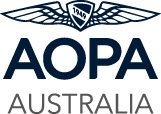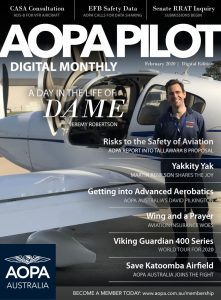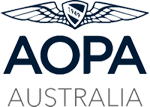AOPA Australia Charter & Flight Training Advisory Group Chairperson, Ms Tammy Camelleri, has compiled a Coronavirus GA Tool Kit for general aviation business operators. The kit spotlights areas of difficulty specific to GA with the intention of aiding operators and small businesses with resources across various sectors of the industry.
“I was struggling to access consistent information regarding COVID-19 and GA,” said Tammy. “I sat down in frustration one day and compiled a list of areas specific to GA that need attention during this disruptive time. The Tool Kit outlines the areas that are pertinent to charter ops, and I am happy to make this available to all charter operators and employees across Australia via AOPA’s Charter Advisory Board. I want to reiterate that this kit is a work in progress, and intended to be fully collaborative rather than prescriptive. I encourage others in the industry to add to the kit as they see fit.”
The Tool Kit outlines the specific areas in GA impacted by the virus and will continue to be updated as the situation continues;
Reduction of Aviation Operating Costs to General Aviation
The GA industry will need to reduce outgoing costs and overheads immediately to be able to continue to trade through COVID-19 and to be ready in 3-6 months’ time (or whenever the industry recovers)
Training Rebate
General aviation will need additional income support to be able to train our staff in preparation for the resurgence of the industry. It is anticipated that most aviation related businesses will permanently lose staff to around 20 – 30%. These workers will leave the industry permanently due to industry down turn, and replacement staff will need to be trained to meet the future demand. Training takes time and money to complete, and often requires the need for multiple agencies to be involved.
Re-currency Training Rebate
In addition to newly trained staff, pilots and engineers will need to be made re-current on operations, this cost will be different for each aviation businesses. This will incur a large proportion of associated costs to industry, across General Aviation in addition to RPT operators.

Maintenance of Aircraft Rebate
Aircraft that have been grounded due to operational requirements will need maintenance re-certification undertaken. Maintenance will be ongoing even if the aircraft are not flying. This cost to the operator is ongoing for all aircraft that continue to be airworthy and will vary depending on the aircraft type and certifications. Aircraft operate on calendar and hourly maintenance programs.
Insurance rebates
The General aviation industry has seen a massive increase of insurance costs over the last financial year, with some companies experiencing up to 40% increase due to the insurance companies increasing rates.
Aircraft that are operating will still need to be insured, hangar keeper insurance in addition to individual aircraft insurance has also experienced an increase in costs. These costs could be offset with a rebate percentage.
Airport lease fees
The industry has seen an unprecedented amount of local Councils increasing fees to aviation businesses over the last 8 years. This ongoing issue has been of great concern to industry and has forced many aviation businesses to reduce staff, relocate or close their operations all together. Assistance could be provided via a platform for negotiation with Councils on behalf of industry to reduce airport operating fees to individual aviation businesses which would include lease fees and landing fees.
Apprenticeship support/assist programs
The industry has very little number of new and younger apprentices considering the maintenance industry due to the new CASA part 66 regulations which have increased training costs beyond the reach of most apprentices and their employers. A platform to grow this part of the industry should be considered and robust financial assistance program provided to registered aviation maintenance organizations in the form of an LAME Apprentice Scheme implemented.

The Tool Kit also addresses the questions asked regarding support and resources for GA:
GENERAL AVIATION FREQUENTLY ASKED QUESTIONS
1. Where can I access relevant financial support for my small business?
Various funding assistance is available to Australian businesses through the ATO however the government will not apply these additional relief options automatically. Contact information is found on the following link and always gain advice from a trusted taxation professional for your business https://www.ato.gov.au/About-ATO/contact-us/phone-us.
ATO assistance for business includes access to PAYG offset, small business asset write offs up to $150k, Job Keeper assistance of $1500 per fortnight, small business cash flow boost, accelerated depreciation via taxation, & small business loan pause.
- COVID-19 Business assistance link – https://treasury.gov.au/coronavirus/businesses
- Business Instant asset write off funding – https://www.ato.gov.au/Business/Depreciation-and-capital-expenses-and-allowances/Simpler-depreciation-for-small-business/Instant-asset-write-off/
- Job Keeper Registration – https://www.ato.gov.au/general/gen/JobKeeper-payment/
- Accelerated Depreciation – https://www.ato.gov.au/Business/Depreciation-and-capital-expenses-and-allowances/Backing-business-investment—accelerated-depreciation/
- Small Business Cash Flow Boost ATO – https://www.ato.gov.au/Business/Business-activity-statements-(BAS)/In-detail/Boosting-cash-flow-for-employers/
- Pause on Small business loans – https://www.ausbanking.org.au/covid-19-relief-faq
2. Where can I find the details on the Government Aviation support package?
Although there is very little available to GA through this assistance, there will still be some assistance available to assist with Airways costs, as well as the aviation fuel tax offset.
First round of funding via support for Coronavirus-affected regions and communities https://treasury.gov.au/sites/default/files/2020-03/Fact_sheet-Assistance_for_severely_affected_regions_and_sectors.pdf
What CASA Regulatory COVID-19 support is available?
- CASA has implemented a number of supportive measures for both individuals and operators during COVID-19.
AOC holder information and resources – https://www.casa.gov.au/about-us/covid-19-advice-industry/exemptions-covid-19/covid-19-alleviation-exemption-guidance-aoc-holders-casa-exemption-5720 - Mandated fatigue transitions changes have been postponed to July 2021 – https://www.casa.gov.au/news-article/more-time-transition-fatigue-rules
- Pilot Medicals information on if you contract COVID-19 – https://www.casa.gov.au/about-us/medical-certification-impacts
- Pilot Medical & license exemptions and extensions under COVID-19 –https://www.casa.gov.au/about-us/covid-19-advice-industry/exemptions-covid-19/exemptions-pilots
- Pilot & Engineer Examination extensions – https://www.casa.gov.au/about-us/news-article/proposed-changes-pilot-and-engineer-exams-during-covid-19
3. Can I continue with my flight training operations?
In a nut shell the CASA answer is ‘yes’ – flight training operations can continue however it is recommended that flight schools follow guidelines to avoid the spread of COVID-19.
However, it is highly recommended that non-essential flight training & recreational flying be postponed to prevent the spread of COVID-19. https://www.casa.gov.au/about-us/covid-19-advice-industry/information-pilots
4. Can I continue to operate commercial flight operations?
Yes general aviation business can continue if the operator believes it is safe to do so. It is recommended that the operators take particular care to adhere to the recommendations for containment of COVID-19 by following the Corona Virus COVID-19 health alert information
https://www.health.gov.au/news/health-alerts/novel-coronavirus-2019-ncov-health-alert/how-to-protect-yourself-and-others-from-coronavirus-covid-19/limits-on-public-gatherings-for-coronavirus-covid-19
5. Do commercial pilots need to wear protective PPE equipment when flying?
Airline crew and pilots are not routinely required to wear any additional PPE for the duration of any flight. However, if a crew member is required to assist a passenger (and their close personal contacts) who is ill, the crew member should:
- wear a surgical mask, disposable full-length gown, gloves and eye protection;
- remove any PPE carefully (without touching the front of mask, gown or outside of gloves) to avoid self-contamination;
- dispose of used PPE carefully in biohazard bags and use alcohol-based hand sanitiser immediately after tying the bag tightly closed;
- and wear gloves to clean then disinfect surrounding surfaces with a broad spectrum disinfectant and use alcohol-based hand rub after removing gloves.
- https://www.casa.gov.au/about-us/covid-19-advice-industry/information-pilots
6. Can I fly interstate on commercial flight operations?
Yes however it is a requirement to contact each state or territory via their web sites to ensure that you are meeting the state laws, Non-essential travel is to be avoided – – international and interstate – should be postponed. If you are flying into different states or territories, or even within your state, it is advised to check with the destination airport to ensure you are able to land.
See Interstate Quarantine for more details –https://www.interstatequarantine.org.au/state-and-territory-border-closures
- Links for individual state and territory border closures.
- NSW – https://www.dpi.nsw.gov.au/home/covid-19
- WA – https://www.wa.gov.au/government/document-collections/covid-19-coronavirus-state-of-emergency-declarations
- SA-https://www.pir.sa.gov.au/emergency_management/covid-19_and_primary_industries
- NT-https://coronavirus.nt.gov.au/
- QLD-https://www.covid19.qld.gov.au/government-actions/border-closing
- VIC-https://www.dhhs.vic.gov.au/coronavirus
- TAS-https://www.dhhs.vic.gov.au/coronavirus
As per the CASA web site https://www.casa.gov.au/about-us/covid-19-advice-industry/information-pilots
‘The advice from government is clear—we should only be travelling interstate or long distances if absolutely essential.
CASA has not placed limitations on airspace and/or valid permissions other than those associated with the current civil aviation regulations. There are restrictions on movements between some states enforced by federal and state authorities.
Visit the Australian Government’s COVID-19 website for national restrictions as well as links to state or territory government health departments for information on local restrictions.
You may also want to contact any aerodromes you are flying into to see what restrictions they may have in place. These details are in ERSA, available through Airservices Australia.’
7. What is the Non-Essential travel definition?
Australia’s health department defines essential and non-essential events, for which travel is necessary. https://www.smartraveller.gov.au/news-and-updates/coronavirus-covid-19
Scott Morrison has told Australians to avoid all “non-essential” travel, in particular interstate travel and longer distances intrastate.
Four jurisdictions – the Northern Territory, South Australia, Western Australia and Tasmania – have effectively closed their borders to outside travel, while the ACT has urged all non-essential travel into surrounding NSW to be postponed.
Under the national guidelines, travel to school, to workplaces and to shops to buy staples are all considered essential, as is travel on compassionate grounds, or for emergencies. The use of public transport for school or work is also considered essential.
8. Should I ask my passengers to sign a liability waiver?
Whilst it is currently the practice of most commercial operations to have insurance to cover them for liability, the COVID-19 situation is an unprecedented and unstable situation which is constantly changing. It is advised that all operators contact their insurance agent directly to gain full clarity and visibility across this question.
9. What cleaning should I do on my aircraft between commercial flights?
It has been suggested that COVID-19 can remain on some surfaces for up to 72 hours.
Cleaning of the aircraft should be completed between each flight with recommended disinfectant solutions, to ensure that all surfaces are clean.
If symptomatic passenger(s) are identified during or immediately after the flight:
Routine cleaning procedures should be followed, and in addition enhanced cleaning procedures should also be used as follows:
- Clean porous (soft) surfaces (e.g., cloth seats, cloth seat belts) at the seat of the symptomatic passenger(s) and within 6 feet (2 meters) of the symptomatic passenger(s) in all directions.
- Clean porous (soft) surfaces (e.g. seat covers and carpet) by removing visible contamination if present and using appropriate cleaners that are compatible with aircraft surfaces and components in accordance with the manufacturer’s instructions. For items that can be laundered, use the warm setting and dry items completely on high heat.
- Clean non-porous (hard) surfaces (e.g., leather or vinyl seats) at the seat of the symptomatic passenger(s) and within 6 feet (2 meters) of the symptomatic passenger(s) in all directions, including: armrests, plastic and metal parts of the seats and seatbacks, tray tables, seat belt latches, light and air controls, cabin crew call button, overhead compartment handles, adjacent walls, bulkheads, windows and window shades, and individual video monitors.
- Clean non-porous (hard) surfaces with disinfectant products with EPA-approved emerging viral pathogens claims that are expected to be effective against the virus that causes COVID-19 (SARS-CoV-2) and ensure these products are compatible with aircraft surfaces and components. All products should be used according to label instructions (e.g., concentration, application method and contact time, PPE).
- Clean lavatories used by the symptomatic passenger(s), including: door handle, locking device, toilet seat, faucet, washbasin, adjacent walls, and counter.
- Properly dispose of any items that cannot be cleaned (e.g., pillows, passenger safety placards, and other similar items as described below).
Recommended Personal Protective Equipment (PPE) during Enhanced Cleaning:
- Disposable gloves that are recommended by the manufacturer of the disinfectant should be worn.
- Disposable gowns should be worn while cleaning the cabin and lavatories.
- If splashing is possible, eye protection, such as a face shield or goggles and facemask may be required according to the manufacture’s label.
Staff should always practice routine handwashing.
- Wash hands often with soap and water for at least 20 seconds, particularly after assisting sick travelers or touching potentially contaminated body fluids or surfaces; after coughing, sneezing, or blowing your nose; after using the restroom; and before preparing or serving food or beverages.
- Use alcohol-based hand sanitizer (containing at least 60% alcohol) if soap and water are not available.
https://www.iata.org/contentassets/094560b4bd9844fda520e9058a0fbe2e/quick-reference-guide-for-ground-handling-in-case-of-covid.pdf - How to Clean and Disinfect https://www.health.gov.au/resources/publications/coronavirus-covid-19-information-about-routine-environmental-cleaning-and-disinfection-in-the-community
Hard (Non-porous) Surfaces
- If surfaces are dirty, they should be cleaned using a detergent or soap and water prior to disinfection.
- For disinfection, most common registered household disinfectants should be effective. o A list of products that are approved for use against the virus that causes COVID-19 https://www.health.gov.au/resources/publications/coronavirus-covid-19-information-about-routine-environmental-cleaning-and-disinfection-in-the-community
- Follow the manufacturer’s instructions for all cleaning and disinfection products for concentration, application method and contact time, etc. o Additionally, diluted household bleach solutions (at least 1000ppm sodium hypochlorite) can be used if appropriate for the surface. Follow manufacturer’s instructions for application, ensuring a contact time of at least 1 minute, and allowing proper ventilation during and after application. Check to ensure the product is not past its expiration date. Never mix household bleach with ammonia or any other cleanser. Unexpired household bleach will be effective against coronaviruses when properly diluted.
Prepare a bleach solution by mixing:
- 5 tablespoons (1/3 cup) bleach per gallon of water or
- 4 teaspoons bleach per quart of water Soft (Porous) Surfaces
- For soft (porous) surfaces such as carpeted floor, rugs, and drapes, remove visible contamination if present and clean with appropriate cleaners indicated for use on these surfaces. After cleaning: o If the items can be laundered, launder items in accordance with the manufacturer’s instructions using the warmest appropriate water setting for the items and then dry items completely.
- Otherwise, use products as recommended by https://www.health.gov.au/resources/publications/coronavirus-covid-19-information-about-routine-environmental-cleaning-and-disinfection-in-the-community and that are suitable for porous surfaces
Electronics:
- For electronics such as aircraft avionics, tablets, touch screens, keyboards, remove visible contamination if present. o Follow the manufacturer’s instructions for all cleaning and disinfection products. o Consider use of wipe able covers for electronics. o If no manufacturer guidance is available, consider the use of alcohol-based wipes or sprays containing at least 70% alcohol to disinfect touch screens. Dry surfaces thoroughly to avoid pooling of liquids.
Linens, Clothing, and Other Items That Go in the Laundry:
- In order to minimize the possibility of dispersing virus through the air, do not shake dirty laundry.
- Wash items as appropriate in accordance with the manufacturer’s instructions. If possible, launder items using the warmest appropriate water setting for the items and dry items completely. Dirty laundry that has been in contact with an ill person can be washed with other people’s items.
- Clean and disinfect hampers or other carts for transporting laundry according to guidance above for hard or soft surfaces.
DISCLAIMER: This toolbox is provided as guidance material only, and any information that is provided is given as guidance information only. As the COVID-19 issue is constantly evolving, it is the ultimate responsibility of any individual or organization to continue to monitor the web sites provided for updated information and to personally validate any information detailed in this documentation. For any financial information please be sure to contact a qualified taxation professional or financial accountant to validate information relevant to your business or situation. The author takes no responsibility for the accuracy of information provided.






